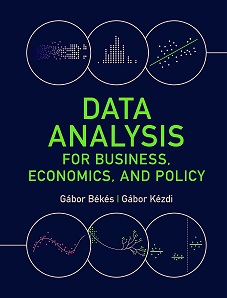Chapter 07 Summary
Chapter 07 Summary
Chapter 07 is about regression analysis, the most widely used method in data analysis. Regression is a model for the conditional mean: the mean of y for different values of one or more x variables. Regression is used to uncover patterns of association. That, in turn, is used in causal analysis, to uncover the effect of x on y, and in predictions, to arrive at a good guess of what the value of y is if we don’t know it, but we know the value of x.
Simple regression analysis uncovers patterns of association between two variables: y and a single x variable. While simple regression is rarely used as the only method in actual data analysis, we spend a lot of time to understand it in detail. We do so because simple regression is a good starting point to most analyses, it is the building block of more complicated methods, and what we learn about it will carry over to multiple regression with appropriate, and usually small, modifications.
In this chapter, we introduce simple non-parametric regression and simple linear regression, and we show how to visualize their results. We then discuss simple linear regression in detail. We introduce the regression equation, how its coefficients are uncovered (estimated) in actual data, and we emphasize how to interpret the coefficients. We introduce the concepts of predicted value and residual and of goodness of fit, and we discuss the relationship between regression and correlation. We end with a note on the relationship between causation and regression.
Case studies
A. Finding a good deal among hotels with simple regression MORE
Learning outcomes
After working through this chapter, you should be able to
- identify problems that call for and lend themselves to regression analysis;
- estimate simple non-parametric regression and simple linear regression using standard statistical software;
- interpret the results of simple linear regression analysis in a precise yet useful and accessible way;
- visualize patterns uncovered by regression analysis.
